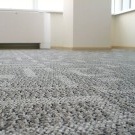Paint with a brush
Very often, when painting surfaces, the paint is applied with a special spray gun (spray gun), or with a roller. When choosing these tools, the time spent on painting is reduced. The surface to be painted is smooth, without stains and gaps. But it is not always convenient to use precisely these painting tools. And then an ordinary, painting brush comes into play. On sale there are round and flat brushes of different sizes, made of natural bristles, or synthetic materials. When painting the surface, use a brush that is most suitable for this. It all depends on the consistency of the paintwork and the surface on which the paint is applied. But most often they use several brushes of different sizes.
Recommendations:
- Before painting, rinse the brush between your fingers, and then blow it;
- You can get an even edge of the surface to be painted using masking tape pasted on a previously drawn vertical or horizontal line. The line can be drawn using a plumb line, cord, or laser level;
- if you purchased a round brush, then in order to prevent it from spraying paint, the length of its hair (bristles) must be reduced (shortened). You can do this very simply by tying the bristles of the brush around with a ribbon, a tourniquet to the length you need;
- brush should be kept at an angle of 45-600 to the painted surface. The brush is not completely immersed in the paint, about a quarter of its length. Then, if there is excess paint on the brush, it is removed on the edge of the container into which the paint is poured;
- when painting the ceiling, so that the paint does not drip onto the handle of the brush, you can use an old, small rubber ball. Cutting it in half, and putting it on the handle of the brush, you can avoid getting paint on the floor and on the handle itself.
- they start painting from especially hard-to-reach places: edges, corners, embossed surface. Then proceed to the main, flat surface;
- first, paint, with uniform movements, apply to the surface in one direction (for example, from left to right). After that, they paint in the direction that is perpendicular to the previous one (from top to bottom), and very carefully blend the paint, until the surface is completely, evenly painted;
- when painting horizontal surfaces, the final touches are applied along the long sides. When painting vertical surfaces, movements should be directed from top to bottom;
- the surface, the area of which is quite significant, is best divided into several, preferably limited by planks or seams sections. But it is necessary to consider what type of paintwork you are using. If it is paint on a drying oil, then the surface can be painted all at once. Oil enamel is best applied to small areas.
- When painting embossed surfaces, remember that it is not necessary to apply a large amount of paint, otherwise the paint will drain, poorly dry and wrinkle the surface.
Good luck with your work.


